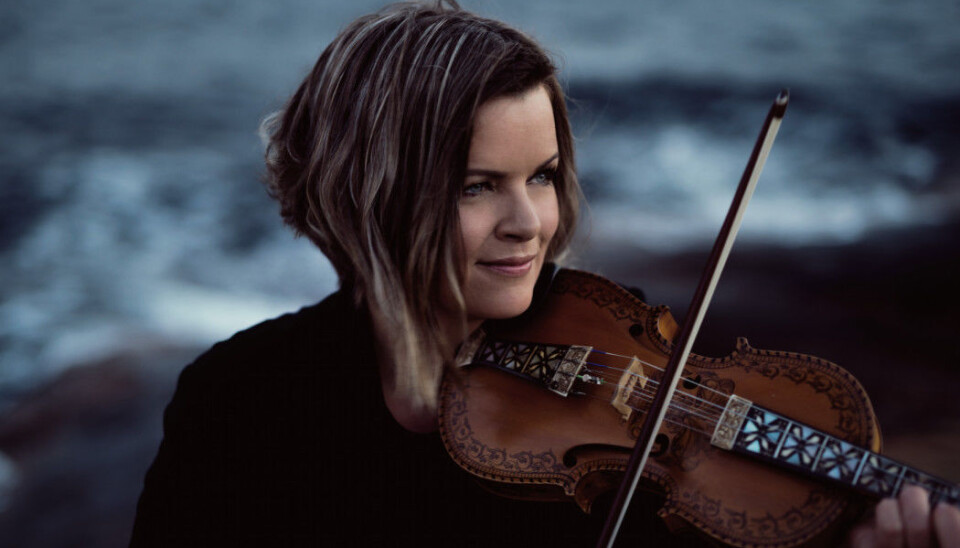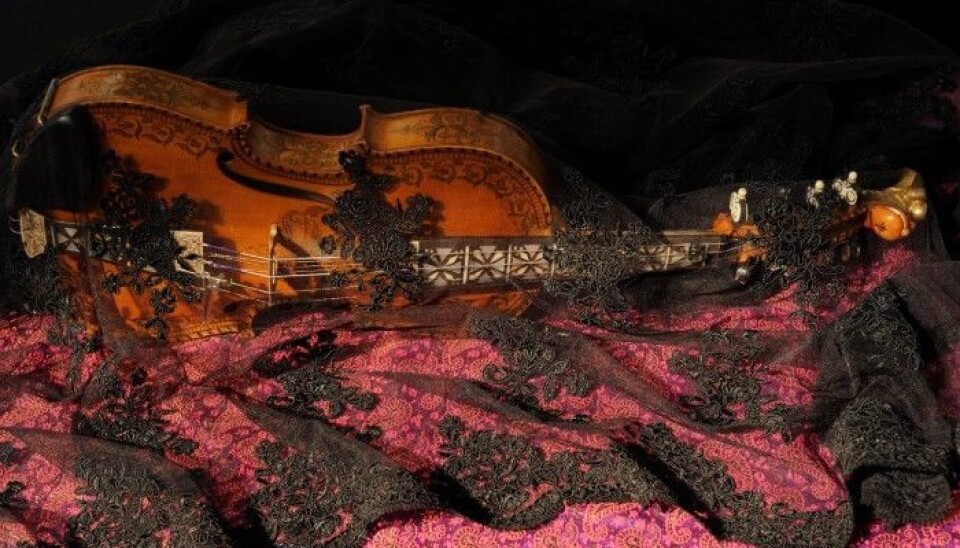
Folk musician Annbjørg Lien's PhD on Hardanger fiddle folk tunes includes a new solo album
One of Norway’s most well-known folk musicians has done a PhD. But there was a limit to how much she could put into words in her dissertation. One of the chapters is consequently being delivered as a new solo album this spring.
She had been on the road for more than 30 years, playing concerts and doing what she loves most: standing on a stage and playing folk music.
But during the last four years, Annbjørg Lien’s Hardanger fiddle has been quite quiet — in public at least. But that doesn't mean she has put it away.
Now that she has just handed in her doctoral dissertation, it has made the Hardanger fiddle more a part of her music than ever before, she says.
“I needed to take a break, in the middle of my life, fill up with new knowledge, think about things and get a bigger perspective on what I'm doing."
Performing doctorate
Annbjørg Lien did not come from an academic background in music. But a slightly different programme for performers at the University of Agder has enabled her to take the university's highest degree.
“This has been an important opportunity to dig deeper into the performing arts,” she says.
Today, much of Norway’s folk music is shared via music theory, recordings and notes, although studying with a master and teaching orally is still highly valued. The Norwegian Academy of Music and the Raulands and Ole Bull Academies offer master’s degrees in folk music.
When Lien started playing seriously, it wasn’t possible to follow an academic path into music. She was educated in the old way and learned directly from the masters.
She is grateful for that.
She says it is incredibly important that a bridge be built using theory as the link between performing arts and academia. But she still hopes that it is possible to bring back more of the oral tradition of teaching.
It started in a basement in Sula
Starting as a five-year-old, Lien learned to play Hardanger fiddle at home in Sula, outside Ålesund, miles away from any folk music environment.
Her father recorded folk music on NRK Radio every week and learned how to play the Hardanger fiddle from Sigbjørn Bernhoft Osa in his adulthood. Eventually, he built up a small group of young people in the village who met every Tuesday in the family’s basement to play.
It was to be the start of a fantastic music career for his daughter, who has always loved the sound of this special fiddle, with its four or five extra, sympathetic strings.
Lived at a master's house
In the 1990s, she moved in for a period with one of her great role models, the musician Hauk Buen.
“Being allowed to be close to the soul of an artist and his entire creative being over time is valuable and educational. I became familiar with emotions, thoughts and creativity, and learnt a lot of techniques,” she says.
But why, you might wonder, was it so important for Lien get to know the feelings of an artist?
“You may be technically proficient, but the art dies if it doesn’t burn bright. You have to have this to move other people and yourself,” she says.
A chapter in her dissertation is a CD
The act of creating can be seen as a private process, and as an artist, you may not want to put the experience into words and share it with others. But it is still important to share how you play with the next generation of musicians. And they are becoming more numerous now, according to Lien.
There has been little theory on the Hardanger fiddle to date, she says. By becoming aware of what she does when she plays, it makes it easier to pass on knowledge to others.
“It’s useful to say why I put my third finger on the second string with my second finger on the third string. Why isn't my first finger with my third finger there? If we don’t put words to the experience, it can get quite muddy in an educational situation,” she says.
But there is still a limit to how much you can put into words, says the folk musician.
For that reason, the last chapter before the conclusion in her dissertation is a CD.
“At one point I needed to stop using words. Otherwise, the mystery of the art would have lost its power. I think it is in the space of silent knowledge that much of this magic pulsates,” she says.

Dove deep into folk tunes
Lien has developed a theory in her dissertation on how to play the Hardanger fiddle.
She dove deep into the characteristics of the folk tune, which is what the melody for a Hardanger fiddle is called. Her theme is how to use styles of playing from the Hardanger fiddle as a tool to compose new music.
“There are these characteristics, or mainstays, that may be the reason why you recognize a Hardanger fiddle tune, even though it has changed under the fingers of various players over several generations,” she says.
She has first and foremost been trying to describe in text how a tune is "fingered", meaning where the musician puts his or her fingers on the fiddle, not how it sounds.
“When you sit and learn from a master, you first and foremost observe the fingers, the bow and the foot tramp. That’s why this perspective on fingering for folk music is immensely interesting to introduce as a language into academia,” she says.
Lots of travellers blood in how the music is played
Lien has based her study on traditional music from Setesdal, a valley in southern Norway.
“My analysis is based on folk tunes played by Hardanger fiddle champion Andres Rysstad, an artist I have listened to and admire a lot,” she says.
The first time she attended a "kappleik", a folk music contest was in Setesdal when she was 15 years old. She was very well received by local artists Kirsten Bråten Berg, Hallvard and Torleiv Bjørgum and Gunnar Stubseid, with whom she also worked later.
When she came back to do ethnographic fieldwork, she found that the people in these valleys who love the old ways and are proud of their traditions were very willing to share their knowledge.
A lot of exciting things came to light during this work.
“Many people believe that Setesdal has been closed to the outside world, but it has on the contrary been a great passageway. Many travellers moved through the valley, for example. They were skilled fiddlers and often shared their tunes with local fiddlers. That's why there may be a lot of travellers blood in the music,” Lien says.
Part of the world's cultural heritage
Setesdal is an area with strong artistic roots, both past and present. One per cent of the inhabitants of Bygland, Valle and Bykle are performing fiddlers. Five per cent are singers and 15 percent are dancers, according to a 2017 article from NRK, the Norwegian Broadcasting Corporation.
Recently, a kind of folk dancing and singing called stevkunst, as well as dance and folk music from Setesdal were placed on UNESCO's World Heritage List for Intangible Cultural Heritage, according to an article from NRK in December 2019.
Lien is very optimistic on behalf of Norwegian folk music and the Hardanger fiddle’s future, not only in Norway, but also internationally.

“Folk music is growing rapidly in popularity both nationally and internationally. We have been a little behind here in Norway. What has been common in several countries for a long time is that folk music has become a kind of lifestyle where musicians play their fiddles in the pub and in other social groups. This is happening here as well, where we are finally beginning to grow experienced enough to be proud of our own,” she says.
Today it is just as common for a child in the city to learn the Hardanger fiddle as a child in Setesdal, according to Lien.
Full speed out into the world
And the Hardanger fiddle is now being discovered internationally.
“Top fiddlers from different parts of the world are travelling to Norway to buy Hardanger fiddles and want to learn this music. They have great admiration for both the instrument and the tunes. Today, there are Hardanger fiddlers in Tokyo, even,” she says.
Lien says one of the attractions of the Hardanger fiddle is that it is an orchestra in itself.
“It has resonant strings that blend in when many strings are played. It therefore fills a room with a rich, large sound. In addition, the rhythm of the music is both complex and suggestive,” she says.
And then there’s the form the tunes take, which can be perceived more as an Indian raga improvisation than other European music, Lien says.
“The fiddle is also fortunately fretless, which means your fingers can be placed freely and in a varied way so that they resonate with the performer's needs and wishes."
New solo album
In the spring of 2020, the eight new songs that are a result of her doctorate will be released by Grappa Music Publishing as a new solo album.
Lien says that academic life has made her a different artist.
“As an artist, you often live in your own mental universe and focus mostly on your own image. As an academic, you must constantly be aware of the field's different opinions and perspectives. The profusion of diversity is one of the most important things I have come to learn about in this research,” she said.
Although the artistic signature she has maintained over the last 30 years is pretty well established, her doctorate has given her a new kind of consciousness. It has led to different types of compositions than before.
“My research has brought me into artistic swing again,” says Lien.
Hardanger fiddle finds its place
She now finds that the Hardanger fiddle more clearly shows its characteristic style in the new compositions, though still in a modern setting.
“Before, there was probably more of a compromise. Now the band more closely follows the compositional characteristics of the Hardanger fiddle. The fiddle is more at home,” she says.
Lien doesn't quite know where the next detour in her life will lead her.
“There are many ways I can use what I have learned — I can be both a performer and an educator, outside and within academia,” she said.
She likes to both teach and play for people on stage. But now she has also developed a love for academia and is already thinking about the scientific articles she can write that she didn’t manage to fit into her dissertation.
“It’s now that my life begins,” says the 48-year-old.































